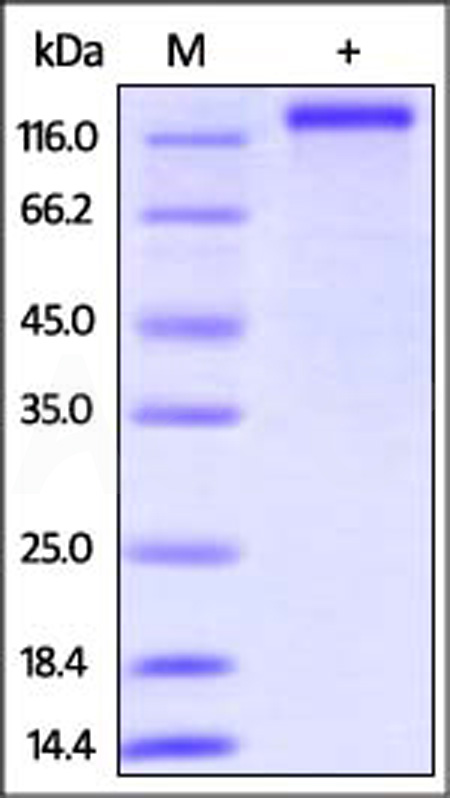分子别名(Synonym)
CD163,M130
表达区间及表达系统(Source)
Human CD163, His Tag (CD3-H52E8) is expressed from human 293 cells (HEK293). It contains AA Ser 42 - Ser 1045 (Accession # Q86VB7).
Predicted N-terminus: Ser 42
Request for sequence
蛋白结构(Molecular Characterization)

This protein carries a polyhistidine tag at the C-terminus.
The protein has a calculated MW of 110.4 kDa. The protein migrates as 135-140 kDa under reducing (R) condition (SDS-PAGE) due to glycosylation.
内毒素(Endotoxin)
Less than 1.0 EU per μg by the LAL method.
纯度(Purity)
>95% as determined by SDS-PAGE.
制剂(Formulation)
Lyophilized from 0.22 μm filtered solution in PBS, pH7.4. Normally trehalose is added as protectant before lyophilization.
Contact us for customized product form or formulation.
重构方法(Reconstitution)
Please see Certificate of Analysis for specific instructions.
For best performance, we strongly recommend you to follow the reconstitution protocol provided in the CoA.
存储(Storage)
For long term storage, the product should be stored at lyophilized state at -20°C or lower.
Please avoid repeated freeze-thaw cycles.
This product is stable after storage at:
- -20°C to -70°C for 12 months in lyophilized state;
- -70°C for 3 months under sterile conditions after reconstitution.
质量管理控制体系(QMS)
电泳(SDS-PAGE)

Human CD163, His Tag on SDS-PAGE under reducing (R) condition. The gel was stained with Coomassie Blue. The purity of the protein is greater than 95%.
 +添加评论
+添加评论背景(Background)
Scavenger receptor cysteine-rich type 1 protein M130 (CD163) is also known as hemoglobin scavenger receptor, which is a scavenger receptor for the hemoglobin-haptoglobin complex. CD163 has also been shown to mark cells of monocyte/macrophage lineage. A soluble form of the receptor exists in plasma, commonly denoted sCD163. sCD163 is generated by ectodomain shedding of the membrane bound receptor. sCD163 is upregulated in a large range of inflammatory diseases including liver cirrhosis, type 2 diabetes, macrophage activation syndrome, Gaucher's disease, sepsis, HIV infection, rheumatoid arthritis and Hodgkin Lymphoma.























































 膜杰作
膜杰作 Star Staining
Star Staining













 Loading ...
Loading ...




